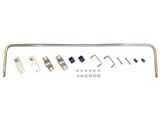A car has "neutral" steering when while turning in tight circle at moderate speed the car will complete the circle at approximately the same position across the diameter of the circle.
A car has "understeer" when turning on the same tight circle at the same moderate speed the diameter of the circle is increased because of the front wheels "pushing" out.
A car with "oversteer" will have a tendency to make a much tighter circle than desired due to the rear end "sliding" out.
All production cars are designed with "understeer" since in the minds of the engineers this is safer and easier to control.
Lifting your foot off the gas pedal will stop the car understeering.
A basic rule of thumb, ignoring the effects of tires, horsepower, etc.: If the car oversteers (back-end slides) you increase the size of the front sway bar; if the car understeers or "pushes", then you incease the size of the rear bar. You can look at changing the size (or installing) a sway bar in two ways; if the cars "pushes" at the front you install a bar at the rear to force it to have less traction and thus making the car more neutral, or the technically correct logic says that you are changing the weight transfer characteristics of the front by transferring more load from the front to the rear.
The stock Bugeye was not supplied from the factory with any sway bars, later spridgets have a small front bar. This minimized the tendency for the car to be tail happy (spin-out/oversteer). The higher your cornering expectations, the higher the horsepower, the bigger the tires, the more you will have to adjust sway bars.
131ADDCO
3/4" front bar for all models
901ADDCO
5/8" rear bar for 1/4 elliptic spring models
221ADDCO
5/8" rear bar for 1/2 elliptic spring models
879ADCO
7/8" front bar for all models
RIC1025
1¼" tubular front bar, splined, with special arms, for special race applications.









